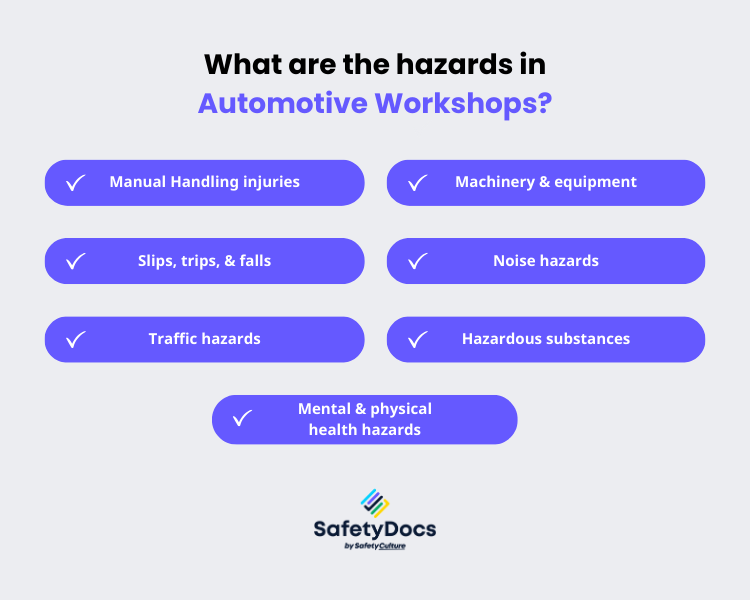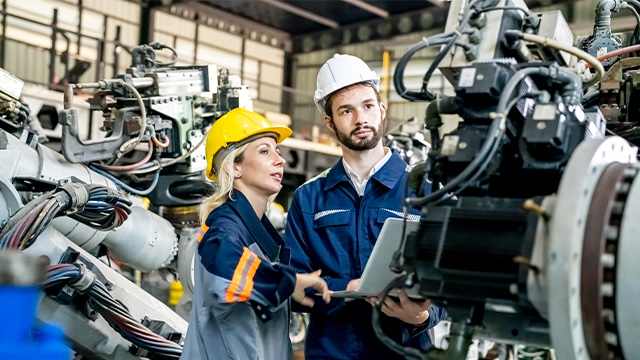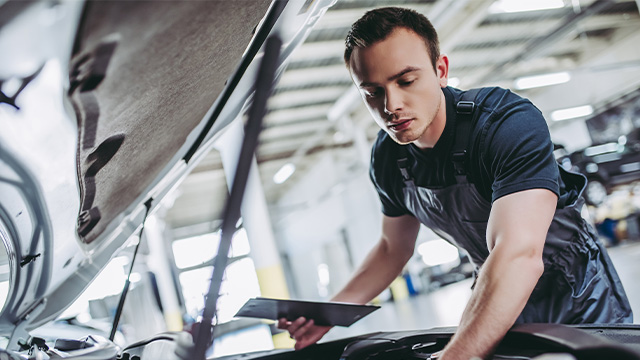Think of the tools, machinery, and substances in a typical automotive workshop. The potential for accidents is all around, from heavy lifts and power tools to chemicals and fumes. That's why a proactive approach to safety is crucial. By understanding the risks and implementing the right safeguards, you can create a workshop where everyone works with confidence and accidents are kept to a minimum.
Automotive workshops are dynamic environments filled with potential hazards. That's why prioritising health and safety isn't just a good idea – it's essential for protecting workers, minimising risks, streamlining operations, and preventing accidents. In this guide, we'll explore how to maintain a safe work environment in automotive repair and servicing settings by understanding those hazards and the best ways to manage them.

Hazards in Automotive Workshops
Automotive workshops can present a range of hazards. From heavy-duty machinery to dangerous chemicals, there are many motor vehicle risks that mechanics and technicians need to be aware of.
1. Manual Handling injuries
Dangerous manual handling tasks
Manual handling tasks such as repetitive bending, stretching, reaching, static lifting, or moving equipment can strain the body. This can result in manual handling injuries and overexertion, which are prevalent and expensive in this industry. Damage to the body can build up over time, leading to chronic pain and discomfort.
Wheel and tyre fitting
Primary risks in a workshop come from handling heavy wheels and tyres, particularly when changing them on vehicles. When lifting these heavy objects, mechanics and technicians must ensure proper posture and use equipment such as trolleys to prevent strain on their bodies. Risks include musculoskeletal disorders, hand-arm vibration syndrome, and injuries from punctures or burst tyres.
Woking inside vehicle cabins
Inside a vehicle cabin is a confined and potentially hazardous space. Technicians should always be cautious when working inside a vehicle cabin, as it may contain sharp edges, hot surfaces, or chemical fumes.
Working under bonnets
Bonnets or hoods have the risk of crushing injuries or burns from hot engine parts. For instance, a technician may need to access the engine compartment for repairs, and the bonnet suddenly falls or slips from its prop.
Working under vehicles
Workers in automotive repair shops may need to work under vehicles for various tasks, such as changing oil or repairing exhaust systems. This exposes them to risks such as being hit by a falling vehicle, crushed by a jack or hoist, or slipping on slippery surfaces.
2. Machinery and equipment
Working with heavy machinery and equipment is common in automotive repair shops. Here are some machines and equipment that pose hazards and safety precautions to take:
Power tools
Tools like air guns, angle grinders, and impact wrenches are used regularly in automotive repair shops. Improper handling can make them hazardous. Kickbacks can result in severe lacerations. Discs may fracture or disintegrate. The debris generated could cause eye injuries or get stuck in other bodily regions.
Compressors and compressed gases
Compressors are used to power air tools in automotive shops. Compressed gases, such as oxygen and acetylene, are also commonly used for welding and cutting. Improper use or storage of these gases could result in explosions or fires, Asphyxiation, and other serious injuries.
Electrical equipment
Working with electrical systems in vehicles poses a significant risk of electric shock or electrocution, and severe burns. Most tasks in an auto repair shop involve electrical equipment, such as batteries, alternators, and starters. If not handled properly, these could lead to serious accidents.
Welding equipment
Welding equipment is used in automotive shops for repairing and fabricating metal components. Incorrect use or handling of welding equipment can lead to burns, eye injuries, electric shock, and fires.

3. Slips, trips, and falls
Slips, trips, and falls are the second most common cause of workplace injuries, and they can be caused by spills, clutter, uneven surfaces, or poorly maintained walkways, floors, stairs, and landings. It is important to keep work areas clean and clear of potential hazards and to wear appropriate footwear with slip-resistant soles. Service pits and vehicle
4. Noise hazards
Working in an automotive shop can expose mechanics to loud noise levels from diagnostic tools, power tools, engines running, and air compressors. Long exposure to high noise levels can result in hearing impairment or other auditory issues.
5. Traffic hazards
The movement of vehicles inside and outside the shop can cause accidents. For instance, a mechanic working on a vehicle could be struck by another vehicle entering or exiting the shop. Forklifts, delivery trucks, and other moving vehicles can cause collisions due to blind spots or careless driving. People who work with or near vehicles, customers, and visitors are at higher risk of injury.
6. Hazardous substances
Brake pads and clutch linings containing asbestos, lead from battery terminals, and various chemicals in automotive repair pose health risks. Mechanics working in poorly ventilated areas face dangers from dust, fumes, and gases, leading to respiratory issues and skin irritation. Safety precautions are crucial to prevent health problems.
Furthermore, vehicle emissions present another prevalent threat. Exposure to carbon monoxide, nitrogen oxides, and other pollutants can result in symptoms like dizziness, headaches, and severe health conditions. Regarding painting tasks, spray painting and powder coating may emit volatile organic compounds (VOCs) dangerous to human health.
7. Mental and physical health hazards
The automotive industry also presents mental and physical health hazards. Mechanics often work long hours, leading to fatigue. Moreover, the fast-paced nature of the industry can lead to high-stress levels and burnout. This is especially true for mechanics who own businesses or work on commission, as they may feel pressure to complete jobs quickly and efficiently.
Alcohol and drug use can also be a problem in the automotive industry. Many mechanics often work near hazardous chemicals and may turn to substance abuse as a coping mechanism for stress or fatigue. This not only puts their health at risk but also poses a danger to others if they are under the influence while working.
Managing Hazards: Steps to Safety
Mechanical service centres present a variety of potential hazards for both workers and customers. These can include exposure to chemicals, moving machinery, electrical dangers, and ergonomic risks. To ensure a safe environment and compliance with Work, Health and Safety (WHS) regulations, automotive repair and mechanical service centres need to prioritise risk mitigation. Implementing a range of safety measures is crucial:
1. Implement the hierarchy of controls
The hierarchy of risk control outlines various methods for mitigating risks, ranging from the most effective to the least. It is a ranking system that helps determine the best course of action for preventing accidents and injuries.
Level 1 Control Measures (Elimination)
- Customer Safety: Restrict customer access to the active workshop area. Establish a designated waiting room and a policy where vehicles are dropped off and retrieved outside the work bays. This eliminates the risk of customers being injured by equipment, vehicles, or ongoing work.
- Compressed Air Hazards: Replace the use of compressed air for cleaning parts with a dedicated parts washer system, eliminating the risk of flying debris and potential injuries.
- Waste Disposal: Partner with a specialised waste disposal service that collects hazardous materials like used oil, filters, and batteries. This eliminates the need for on-site storage and the associated risks.
Level 2 control measures
If elimination is impossible, minimise the hazards through:
- Substitution: This involves replacing hazardous materials or processes with safer ones. For instance, using water-based paints instead of solvent-based ones can significantly reduce health risks for workers and customers.
- Isolation: This method involves physically isolating the hazard from people. For instance, placing a guard around dangerous machinery or using soundproofing materials to reduce noise levels.
- Engineering controls: These involve designing systems or equipment that minimise hazards. In an auto shop setting, this could include installing ventilation systems to remove fumes from the workspace or implementing noise-reducing measures to protect against hearing loss.
Level 3 control measures
These measures rely on human behaviour and supervision rather than controlling the hazard at its source, like the previous levels. They include:
- Administrative controls: These measures involve implementing policies and procedures to reduce risks. For example, limiting the number of hours employees can be exposed to hazardous materials or requiring regular breaks for tasks that require repetitive motions.
- Training and education: Providing workers with proper training and education on identifying and handling hazards is crucial for creating a safe workplace. This should include information on warning signs, emergency protocols, and correct usage of PPE.
- Personal protective equipment (PPE): This includes gloves, goggles, and masks that workers can use to protect themselves from hazards.
2. Develop a work health and safety policy
Enhance workplace health and safety by clearly outlining the responsibilities of all individuals, including team leaders and supervisors. A work health and safety policy is the way to achieve this. A work health and safety policy outlines the company's commitment to providing all employees with a safe and healthy working environment. The Person Conducting a Business or Undertaking (PCBU) must take reasonable care and ensure that all workers, including contractors and volunteers, know their health and safety rights and responsibilities.
The policy must include:
- Responsibilities: Clear delineation of the roles and responsibilities of management, supervisors, employees, and any safety committees or representatives
- Risk Management: Procedures for identifying, assessing, and managing workplace hazards and risks, including risk assessment methodologies
- Safety Procedures and Protocols: Detailed guidelines for safe work practices, including procedures for chemical handling, equipment operation, vehicle maintenance, and emergency response.
- Incident Reporting and Investigation: Procedures for reporting workplace incidents, injuries, near misses, and hazardous conditions, as well as protocols for conducting thorough incident investigations and implementing corrective actions.
- Emergency Preparedness: Plans and procedures for responding to emergencies, including fire evacuation drills, medical emergencies, chemical spills, and other hazardous situations.
- Communication and Consultation: Mechanisms for promoting communication and consultation between management and employees regarding safety matters, such as safety meetings, suggestion boxes, and feedback channels.
3. Involve your workers
Consulting with workers is essential to creating a safe and healthy workplace. Workers are often on the front lines in repair and servicing settings and can provide valuable insights into potential hazards or risks. Their insights are valuable in the development of safety protocols and mitigation plans.
4. Train and supervise workers
Proper training and supervision are crucial, especially in automotive worksites. Training should cover safety procedures, such as using personal protective equipment (PPE) and emergency response protocols in case of chemical spills and other hazardous situations. Supervisors should ensure workers follow safety protocols and promptly address any issues to prevent accidents or injuries.
5. Maintain established vehicle safety systems and procedures
Safety protocols and procedures must be maintained continually to ensure their effectiveness. This includes:
- Conducting regular equipment inspections and maintenance checks to ensure they're safe to use
- Staying updated on the latest product label information, Safety Data Sheets (SDS), and manufacturer's manuals
- Informing workers of any changes to safety procedures or equipment
- Conducting regular safety drills and training to refresh workers on emergency response protocols
6. Practise good record-keeping
Keeping a record of all safety procedures and equipment inspections is crucial for maintaining a safe work environment. This includes documenting any changes to procedures or equipment and tracking incidents or near-misses. Maintaining records enables you to effectively monitor your business's health and safety performance and comply with legal obligations.
Safety documents that you should keep include:
- WHS Policy
- Record of Safety Meetings
- List of Hazards and Risk Assessment
- Hazardous Substance Register
- Risk Management Plan
- Induction Checklist
- Training Record
- Emergency Response Plan
- Incident/Hazard Report
- Permit for Entry into Confined Spaces
- Safety Management Systems
7. Use Automotive Safe Operating Procedures (SOP): Your Workshop's Roadmap to Safety and Success
SOPs provide detailed step-by-step instructions for specific tasks, ensuring all workers follow the same safety protocols. In the automotive industry, SOPs are absolutely crucial, covering topics such as working with hazardous materials, handling equipment, and operating machinery.
Boost Your Workshop with the Automotive Motor Vehicle Servicing & Repair SOP Pack
To streamline your SOP creation, consider the Automotive Motor Vehicle Servicing & Repair SOP Pack. This comprehensive set of pre-written SOPs provides a solid foundation for your workshop's safety procedures. You'll benefit from:
- Safety Compliance: Ensure your workshop aligns with industry best practices and safety regulations.
- Efficient Training: Bring new employees up to speed quickly with clear, established procedures.
- Process Optimisation: SOPs help you analyse your workflow, identify potential bottlenecks, and make continual improvements.

Start the Safety Culture in Your Workshop
Automotive repair shops use heavy machinery, flammable materials, and hazardous chemicals which are all high-risk. High-risk activities are required to comply with the Safe Work Australia guidelines for managing risks in the workplace. SafetyDocs by SafetyCulture can help with safety and compliance. We have a range of industry-specific templates that can be customised to fit your workshop's needs. We have templates specifically for every task in your workshop, including safety procedures, safe work method statements, management systems, and checklists.
Streamline your workshop's safety procedures with the following additional documents:
- Automotive Asbestos Management Plan
- Integrated Industry Suite for Automotive Servicing & Repair
- Automotive Servicing & Repair OHS-WHS Industry Suite
Take the first step towards a safer and more compliant workshop today with SafetyDocs.
We simplify prioritising safety and compliance so you can focus on what you do best - providing top-quality customer services. Contact us now to learn more about our templates and how they can benefit your workshop.
Our team of experts is dedicated to providing accurate and informative content. Craig Cruickshank, our senior HSEQ advisor at SafetyDocs by SafetyCulture has reviewed this blog post to ensure the highest level of quality.
Learn more about Craig's work on LinkedIn for more industry insights.
Available for instant download and supplied in fully editable MS Word format for use in your business.
Please note that the above information is provided as a comment only and should not be relied on as professional, legal or financial advice.
Share This Article
